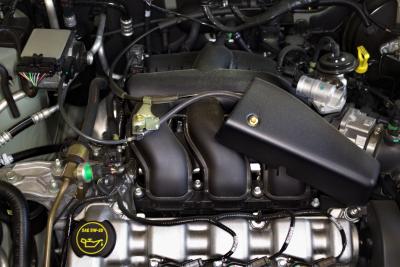
To bore an engine block, automotive machine shops use special equipment to smooth out the surface of scratched, scored or excessively worn engine cylinders. They actually remove a thin layer of metal to within thousandths of an inch of the piston size that will be used to rebuild the block, says James Duffy in “Modern Automotive Technology.” However, you can proceed with the next step of the process--engine honing--to reach the cylinder's final size and finish.
Mount your clean engine block on a stand or set it securely on a hard top workbench.
Turn the engine block upside down and install the main bearing caps, tightening them to the torque specified by your vehicle manufacturer using a torque wrench. This information can be found in the vehicle service manual for your particular model.
Attach a flex hone with 133-grit stone to an electric drill.
Put on your goggles.
Mix equal parts of 20 weight oil and kerosene in a suitable, clean container.
Rotate the engine so that you are facing the top of the block at an angle.
Compress the flex hone three legs inward and insert the hone into the number one cylinder bore, being careful not to scratch the cylinder wall. Then carefully release the flex hone legs.
Ask a helper to lubricate the cylinder wall with the mixture you made in Step 5.
Turn on the electric drill to a speed of about 1,400 RPM. At the same time, move the flex hone up and down at a pace that will allow you to create a 50 to 60 degree crosshatch pattern on the cylinder wall. Do this for about three to five minutes until you get rid of all the bore machine marks and create a nice crosshatch pattern. During this procedure, ask your helper to keep the cylinder wall lubricated at all times.
Turn off the electric drill when you are finished, but keep the flex hone moving up and down until the drill comes to a complete stop. This will avoid leaving circular marks on the cylinder wall.
Squeeze the flex hone with your free hand and remove it from the cylinder.
Clean the cylinder wall with a clean, lint-free towel.
Repeat Steps 7 and 8, from the previous section, through 4, of this section, for the remaining cylinders.
Repeat Steps 7 and 8, from the previous section, through Step 5 of this section for the second and third stage of the process. However, during the second stage, use a flex hone with 525-stone grit. For the third and final stage of the process, Brian Styve, in “The Haynes Ford Engine Overhaul Manual,” recommends using 280-grit stone, if you are installing cast-iron or chrome-faced piston rings, or 400-grit stone, if you are installing moly rings.
Chamfer the top edges of each cylinder using a small file to avoid the edge catching on the piston rings during installation.
Wash the engine thoroughly with warm water and soap to remove all grit particles from the block. Use a clean, lint-free towel to wipe the surface. When finished, wipe the cylinder wall with a new piece of toweling and new engine oil. If the towel does not pick up gray matter, the cylinder wall is clean.
Dry the engine completely and apply a light coat of rust preventive oil to all the block surfaces that were worked on.
Wrap the engine block in plastic to keep dust off the surface.